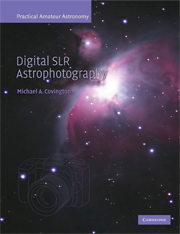C - Digital processing of film images
Published online by Cambridge University Press: 21 August 2009
Summary
You can, of course, process film images with the same software that you use for DSLR images. The grain in each image is different; there is no fixed-pattern noise. Stacking multiple images builds contrast and reduces grain.
First you have to get the film images into digital form. There are many methods. The best is a film scanner with a resolution of at least 2400 dpi (about 100 pixels/mm). This scans each 35-mm slide or negative into a file containing eight or more megapixels, comparable to the resolution of a good DSLR. I use a Nikon Coolscan III (LS-30) and get excellent results. It even has the ability to detect and electronically remove dust and scratches, which, unlike film, are opaque to infrared light.
I have not had good results with flatbed scanners that claim to scan film. In my experience, the flatbed scanner acquires a rather blurred image and then applies a strong sharpening filter to it. It's much better to scan the image faithfully in the first place.
You can use your DSLR to digitize film images. Any slide duplicator attachment that fits a film SLR will also work with a DSLR, except that it may not cover the whole slide because the DSLR sensor is smaller than a film frame. The alternative is to use the DSLR with a macro lens and light box, and simply photograph the slide or negative (Figure C.1).
- Type
- Chapter
- Information
- Digital SLR Astrophotography , pp. 207 - 208Publisher: Cambridge University PressPrint publication year: 2007



